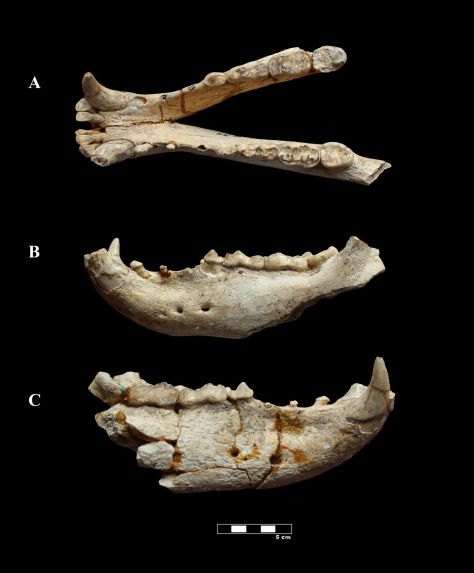NewsNext Previous
A study provides new data on the bears preserved in the site of Dmanisi in the Caucasus 1.8 million years ago
The journal Scientific Reports, edited by the Nature group, clarifies the characteristics of the species Ursus etruscus, the ancestor of the Cave Bear lineage
Three members of IPHES participate in this research: Tsegai Medin, Bienvenido Martínez-Navarro and Florent Rivals
català – español –article – fotos
The Dmanisi site, 1.8 million-years-old, is located in the Republic of Georgia, in the heart of the Caucasus, between the Black Sea and the Caspian Sea. This paleontological locality records the earliest human presence located outside Africa. In addition, it preserves an extraordinary collection of paleontological remains, with a variety of spectacular extinct mammals. This collection of fossils is deposited, together with many others from the rich Georgian sites, in the National Museum of Georgia, in Tbilisi, and is now under study.
This study has been performed by three researchers from the IPHES (Catalan Institute of Human Paleoecology and Social Evolution) and the Prehistory Area of the URV (Rovira i Virgili University of Tarragona) -Tsegai Medin (fellow of the Atapuerca Foundation), Bienvenido Martínez-Navarro and Florent Rivals (ICREA Research Professors)-, together with other paleontologist from the National Museum of Georgia –David Lordkipanidze, Gocha Kiladze and Giorgi Kopaliani-, the University of Málaga-Borja Figueirido and Paul Palmqvist-, and the ICP (Catalan Institute of Paleontology Miquel Crusafont) – Joan Madurell-Malapeira-. They have carried out the classification of the bear fossil remains that inhabited the emblematic paleoanthropological Early Pleistocene site of Dmanisi, and have described the diet of this extinct species. For doing so, the study has combined the anatomical study with the use of morphometric data and other techniques for estimating dental microwear, which have allowed comparing the Dmanisi bears with other fossil and extant species.

The teeth of the Dmanisi bear show a wide variation in size and correspond to the species Ursus etruscus, described two centuries ago, in 1823, by the great French paleontologist Georges Cuvier. Therefore, the systematic adscription of this ursid has been subject to controversy; in fact, in 1995, the late Professor Abesalom Vekua, from the Georgian Academy of Sciences, based on the high differences in size among the specimens, considered that there were two different species at Dmanisi, Ursus etruscus and Ursus sp. However, in this study it is observed that, regardless of size, all the specimens show a very similar anatomical variability. For this reason, the huge differences in the size of teeth are the result of an accused sexual dimorphism, where males are considerably larger than the females, as happens in the modern brown bears as well as in other fossil species. Ursus etruscus is also very well represented in the deposits of Orce: Venta Micena, Fuente Nueva-3 and Barranco León, the last two associated with human presence, as in Dmanisi.
The analysis of tooth microwear reports that the Dmanisi bears lived in a mixed environment, with prairies and patches of open forest, where they fed on fruit, tubercles and tree leaves, complementing their diet with variable amounts of meat and fish. Also, the comparative morphometric analysis of this fossil species with modern bears (brown, polar, Tibetan, etc.) confirms that the species of Dmanisi had an omnivorous diet, similar to that of the current brown bear, Ursus arctos.
The study also allows to discuss, based on this new evidence, on the ecological interactions of this fossil bear with other elements of the fauna, including the first hominins that dispersed outside Africa. It is especially interesting the relationship among the different omnivorous species, basically hominins, bears and pigs, which eat a variety of general foods, vegetable and animal products.
The study concludes that the degree of competition between hominins and bears was less than previously considered, because during the cold winter months, when edible leaves and soft fruits were scarce in the middle latitudes, hominins would have more dependence on animal products (meat and fat) and dry fruits (acorns, nuts, chestnuts, tubers, etc.) and bears would be hibernating. The study also concludes that pigs, which are active during the winter season, would maintain a greater competition with hominins, and this fact could possibly contribute to its extinction in Europe shortly after, disappearing from the European ecosystems during half a million years, until the latest Early Pleistocene, around 1.2 million-years-ago.
Bibliographic reference
Tsegai Medin., Bienvenido Martínez-Navarro, Joan Madurell-Malapeira, Borja Figueirido, Giorgi Kopaliani, Florent Rivals, Giorgi Kiladze, Paul Palmqvist, and David Lordkipanidze, 2019. “The bears from Dmanish and the first dispersal of early Homo out of Africa.” Scientific Reports,


